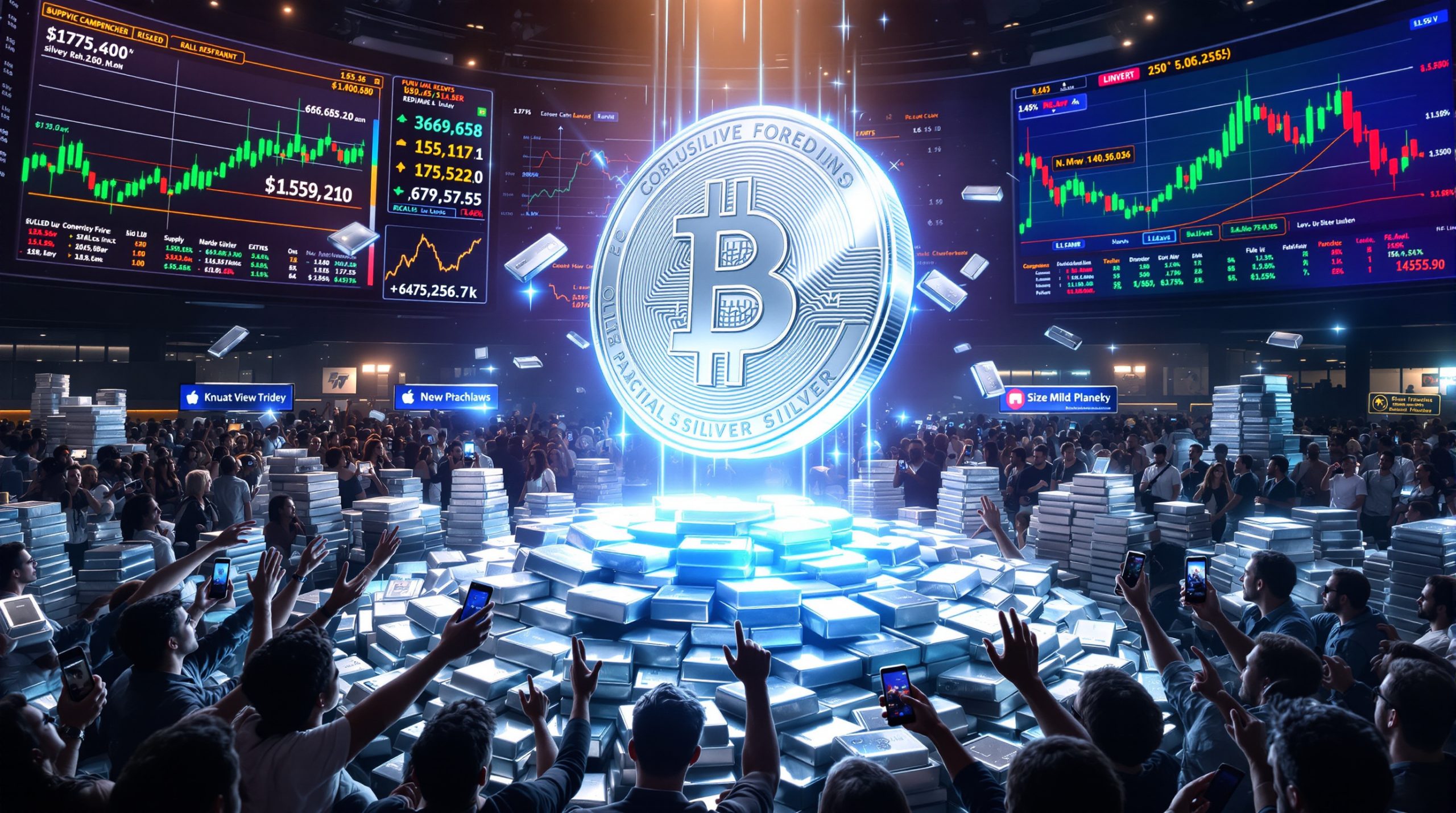A silver squeeze is a market event characterized by a surge in silver prices driven by coordinated buying efforts from investors. This phenomenon occurs when large quantities of physical silver and related investments are purchased, creating a supply shortage and heightened demand. As retail communities increasingly influence market movements, the dynamics of a silver squeeze have captured the attention of investors and analysts alike.
How Does a Silver Squeeze Work?
The mechanics of a silver squeeze are straightforward yet impactful. When a concentrated group of investors adopts a buying strategy, they effectively reduce the available supply of silver. This can involve purchasing physical coins, bars, and exchange-traded funds (ETFs), which tightens the market. Additionally, this buying pressure can significantly impact entities holding short positions in futures markets, leading to a cascade of effects that drive prices higher.
As physical acquisitions increase, they force a realignment between paper contracts and the tangible metal. When available stocks dwindle, prices can soar steeply, creating a feedback loop where rising premiums and heightened market awareness further fuel the buying frenzy.
Market Structure Vulnerabilities
Silver’s unique dual nature—as both an industrial and an investment commodity—exposes it to market vulnerabilities. The volume of paper contracts often far exceeds the actual availability of metal, leading to delivery stress during periods of heightened demand. This imbalance can result in significant price discrepancies, as physical premiums widen when investors rush to secure tangible assets.
Historical data illustrates this divergence. For instance, physical premiums typically expand when demand spikes, highlighting the need for balanced analysis of precious metals to understand these surges better.
Modern Developments and Policy Impact
Recent efforts to exploit market weaknesses have underscored the evolving dynamics of silver trading. Since the onset of coordinated buying moves, refiners and regulators have adapted to manage supply risks. Policy adjustments, such as changes in tariffs, can significantly impact metal costs, further shaping market outcomes.
For example, tariff changes can affect the price of silver, emphasizing the importance of understanding how investor sentiment and regulatory frameworks interact to influence market conditions.
Historical Episodes and Their Relevance
Looking back at historical squeezes provides valuable lessons on market volatility and reactions. Notable events, such as the Hunt Brothers’ attempt to corner the silver market in the late 1970s and the price spike in 2011, demonstrate how extreme coordination can disrupt price equilibrium.
In 1979, silver prices soared dramatically before regulatory measures forced a correction. Similarly, the 2011 spike exhibited sharp price swings, reminding investors of the importance of monitoring market fundamentals.
Key Historical Indicators
Several key indicators can provide insights into potential market movements:
Lease Rates: Elevated borrowing costs signal tightening supply.
Delivery Delays: Prolonged wait times suggest inadequate physical stock.
Premium Expansion: Increased spreads between spot and retail prices indicate market stress.
Comparing these indicators with past squeezes can help forecast possible outcomes, enhancing investors’ understanding of market dynamics.
Investor Evolution and Retail Participation
The rise of retail investors has significantly altered the landscape of silver trading. With expanded access to online platforms and community forums, these new participants can quickly act on market news and trends. Social media has played a crucial role in past events, catalyzing rapid buying initiatives that can lead to future squeeze scenarios.
Dual-Nature Market Characteristics
Several intrinsic features differentiate silver from other assets:
Industrial Demand: Remains steady regardless of speculative fluctuations.
Global Market Scale: Requires immense capital for price influence.
Physical Delivery: Introduces real-world constraints that affect trading.
Hedged Positions: Central bank holdings add further complexity to market dynamics.
Understanding these elements is critical for assessing long-term price stability in the silver market.
Physical vs. Paper Markets
The interplay between physical silver and paper contracts is central to the dynamics of a silver squeeze. In futures markets, paper contracts represent silver, yet only a fraction results in physical delivery. In contrast, physical markets necessitate immediate metal transfer, intensifying delivery pressure.
Exchange-traded products (ETPs) bridge these realms, but disparities between physical and paper markets underscore the importance of actual possession during volatile times.
Risk Management in Volatile Times
Investors must adopt robust risk management strategies when confronting potential squeeze conditions. Here are some steps to consider:
Diversify: Invest in physical metals, ETFs, and mining stocks.
Stay Informed: Remain alert for regulatory changes that could impact the market.
Set Exit Strategies: Have clear plans before entering positions.
Understand Value: Differentiate between intrinsic value and temporary price spikes.
These strategies can help protect investors from unexpected market shifts during periods of intense volatility.
The Critical Role of Physical Silver
Physical silver plays a pivotal role in establishing squeeze conditions. When buyers remove metal from circulation, they reduce available supply and force market participants to adapt quickly. This shortage creates upward pressure on prices and tests the relationship between theoretical contracts and the real commodity.
Investors recognize that securing physical silver can help mitigate exposure to discrepancies in the paper market.
Supply Chain Challenges and Logistical Complexities
The silver supply chain faces several vulnerabilities:
Limited Refining Capacities: Challenge rapid production increases.
Geographic Concentration: Creates bottlenecks in refining operations.
Minting Constraints: Transport logistics can add layers of delay.
During peak demand periods, dealers have reported delays stretching up to several weeks, further amplifying squeeze conditions.
Impact of Silver ETFs
Silver ETFs add complexity by bridging paper and physical markets. They provide easy access to silver but rely on substantial physical backing. Consequently, large inflows can force ETF managers to purchase real metal, tightening supply further.
This dynamic has played out during past events when coordinated retail buying led to record inflows, necessitating substantial acquisitions. Transparency issues surrounding ETF audits continue to fuel debate among investors.
Regulatory and Market Responses
Regulators closely monitor squeeze conditions. When speculative buying distorts the market, rule changes often follow to restore balance between physical and paper markets. Exchanges have modified trading rules during extreme events to protect both individual and institutional investors from uncontrolled volatility.
The Future of Silver Squeeze Dynamics
Looking ahead, the possibility of a future squeeze remains real. As investor coordination improves and market fundamentals shift, the next squeeze could arise unexpectedly. Markets will need to adjust to a landscape where both physical and paper forces interact dynamically.
This evolving scenario suggests that the term “silver squeeze” may soon reappear in discussions, along with renewed emphasis on balancing supply and demand.
Navigating Uncertainty and Strategic Considerations
Investors can better navigate uncertainty through diversified holdings and realistic expectations. Key pointers include:
Balanced Portfolio: Maintain a diverse portfolio across various asset classes.
Market Indicators: Keep abreast of lease rates and delivery times.
Long-Term Perspective: Understand that short-term volatility may lead to long-term structural changes.
Staying informed through reliable sources is crucial. Recent market rallies highlight how sentiment and regulatory factors interplay in determining price trajectories.
Concluding Thoughts on a Silver Squeeze
In summary, the intricate dance between physical supply and paper contracts creates a fertile environment for market disruptions. The delicate balance may precipitate dramatic price movements, as historical episodes have shown. The current environment, characterized by coordinated retail participation and evolving market dynamics, sets the stage for future events.
Ultimately, a measured understanding of these dynamics is essential for all market participants. As the industry continues to innovate, investors must remain vigilant and adaptable. The phenomenon of a silver squeeze serves as a reminder of both market opportunity and inherent risk.
Looking to Capitalize on the Next Big Silver Movement?
Discover potential market-moving mineral discoveries before they hit mainstream news with Discovery Alert’s proprietary Discovery IQ model, which analyzes ASX announcements in real-time to identify high-potential opportunities. Explore how significant mineral discoveries can generate substantial returns by visiting Discovery Alert’s dedicated discoveries page.




